#railroadhistory
Text
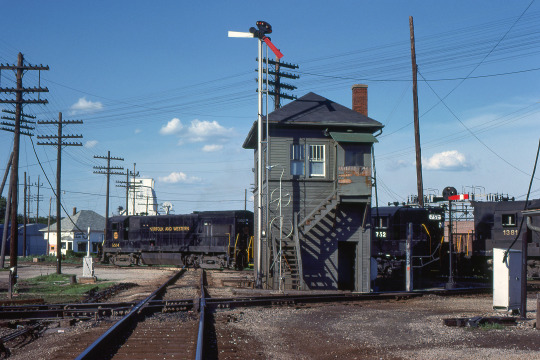
Gibson City, Illinois
This is a triple crossing in the center of Gibson City, Illinois. While two of the three roads at this point are of the Norfolk & Western, formerly it was the Wabash, the Nickel Plate, and the Illinois Central all meeting at this spot.
We’re looking up the Illinois Central (between Clinton and Gilman) while the east/west Nickel Plate is on this side of the tower. The train is northbound on the former Wabash line, between Bement and Chicago, on the other side of the tower.
Note that all of the locomotives have high short hoods, a signature feature for the Norfolk & Western during this time period (along with the Southern Railway).
One image by Richard Koenig; taken May 22nd 1977.
#railroadhistory#railwayhistory#wabashrailroad#nickelplaterailroad#gibsoncityillinois#gibsoncityil#gibsoncity#illinoiscentralrailroad
54 notes
·
View notes
Text
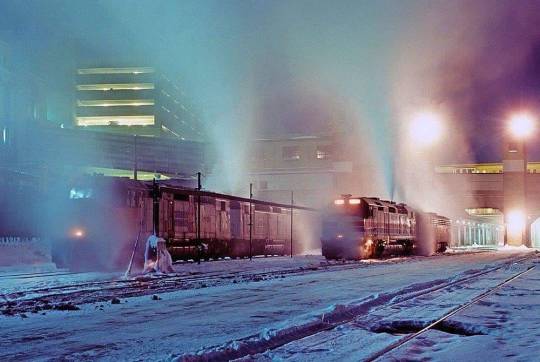
Minneapolis Great Northern Station (1977)
Photo by Steve Glischinski
29 notes
·
View notes
Text

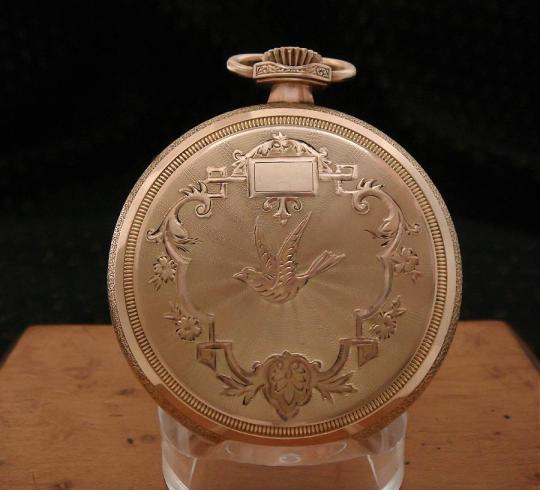


Crisp, High-grade Waltham 23 jewel "Vanguard" railroad pocket watch with rare Montgomery dial, offered in an equally handsome period birds-eye maple presentation box. Circa 1913
#pocketwatch#antiquepocketwatch#antiquewatch#Waltham#walthampocketwatch#MensPocketWatch#mensfashion#walthamvanguard#railroadpocketwatch#railroadhistory#timepiece#menswatches#Watches#vintagewatches#horologicalfinds#horology#ClassicWatches
5 notes
·
View notes
Text
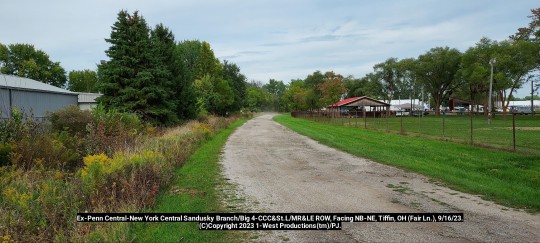
Ex-Penn Central-NYC Sandusky Branch/Big 4 CCC&St.L/MR&LE ROW, Facing SB-SW, Tiffin, OH, Near Fairgrounds, 9/2023. www.1westproductions.com See our blog about this line on our site. https://www.1westproductions.com/big-4-line-cinci-springfield-bellfontaine-carey-tiffin-castalia-sandusky-oh-coverage/
#penncentral#penncentralsanduskybranch#penn central#newyorkcentralrow#new york central#newyorkcentralohiodivision#newyorkcentral#nycsanduskybranch#cccandstl#madriverandlakeerierailroad#trainspotting#trains#railfanning#railroad#trainpics#railroadhistory#1westproductionsvideos#onewestoroductions
0 notes
Photo

The old Draper railroad depot on North Main Street in Eden, North Carolina. #eden #edennc #drapernc #deserve2preserve #saveourhistory #historicpreservationmatters #railroadhistory #railroad #railroaddepot (at Eden, North Carolina) https://www.instagram.com/p/CkLsbVYAWaJ/?igshid=NGJjMDIxMWI=
#eden#edennc#drapernc#deserve2preserve#saveourhistory#historicpreservationmatters#railroadhistory#railroad#railroaddepot
0 notes
Link
Check out this listing I just added to my Poshmark closet: Walthers HO Scale Cornerstone Electric Transformer Kit - Realistic Detailing for.
0 notes
Text
Spotlight on Delaware from Railways to Freeways / First State, Second Phase by Dave Tabler | Author Guest Post ~ 1 Signed Copy Offered | #NonFiction #AmericanHistory #Colonial
"Delaware from Railroads to Freeways by Dave Tabler is a visually stunning book that takes readers on a captivating journey through Delaware's 19th-century history. With engaging narrative and stunning graphics that seem to leap off the page, this book provides an immersive and enthralling reading experience as Tabler chronicles the rich history of Delaware. This is his second installment of a three-part series on the history of Delaware – the First State.... For Delaware natives and enthusiasts, this is probably one of the best-illustrated background books of Delaware's 19th-century history as you can find about the First State. It is truly a captivating book." -- AuthorsReading
Enter #giveaway for a chance to win.
@davetabler_author @iReadBookTours
@davetabler @acornsireadbooktours
#delawarehistory #delaware #history #milforddelaware #delagram #milfordde #delawarephotography #railroad #railroadhistory #railroadmuseum #railfanofinstagram #trains #historyhappenedhere #historyiscool #visitdelaware #thisisdelaware #museumsathome #museumsfromhome #staysafe #locomotive #railfans #delawarepublicarchives #firststate #delmarva #delawarespotlight #delawarebeaches #eventsdar #onlyindelaware
Spotlight on Delaware from Railways to Freeways / First State, Second Phase by Dave Tabler | Author Guest Post ~ 1 Signed Copy Offered | #NonFiction #AmericanHistory #Colonial
A book blog tour from iRead Book Tours.
Thank you to the author, publisher, & Lauren at iRead for providing me with the information for this tour.
Book Details
Content Rating: G. None needed. Works for all…
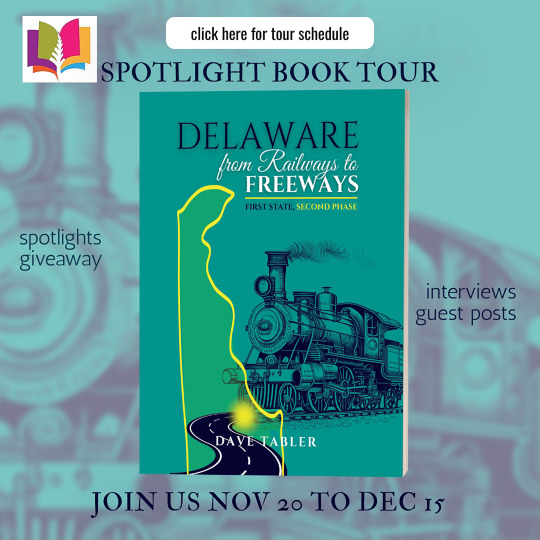
View On WordPress
0 notes
Text
#homegrownkcadventure: Trains!
New special exhibit on how trains transformed Johnson County at the Johnson County Museum.
Also spoke with Curator Andrew Gustafson. That recording will be available to my patron supporters soon.
Exhibit is up until mid Jan 2024.
Homegrown KC is a podcast dedicated to exploring Kansas City's fascinating history and sharing stories from its rich past. It is available wherever podcasts can be found including but not limited to Audible, Amazon Music, Google Music, Pandora, Spotify, and Apple Podcasts.
To become a patron supporter subscribe to redcircle.com/homegrownkc or patreon.com/homegrownkc. Subscribers get access to exclusive bonus episodes featuring other local historians, archivits, and museum professionals. They also receive an item from the merchandise store valued at 5$ or less, and a shout out on every episode and social media post. Or you can give a one time donation at redcircle.com/homegrownkc or Ko-fi.com/homegrownkc. All donors will receive a shout out. And 1% of all Ko-Fi donations will go to fight climate change.
To see what merchandise is available, go to zazzle.com/store/homegrown_kc_store.
For more information on each topic, visit my website: homegrownkc.wordpress.com. and sign up for my monthly newsletter on my website as well.
Like, follow, and subscribe to the show on Facebook, Instagram, Twitter, Pinterest, Tumblr, and Youtube.
Rate and Review the show where you listen, especially on Apple Podcasts.
Thank you Bjorn and Joan for your support. Thanks also goes to Sarah McCombs for the creation of my logo; the Dear Misses for use of their song Kansas City, as the intro and outer music of the show; to local libraries; and to all my wonderful listeners.
Cheers!
#homegrownkc #communityhistory #stateandlocalhistory #kchistory #kcproud #historypodcast #podcastersofinstagram #johnsoncountymuseum #trains #railroadhistory #trainhistory
instagram
0 notes
Text
New Donation & Artifact!
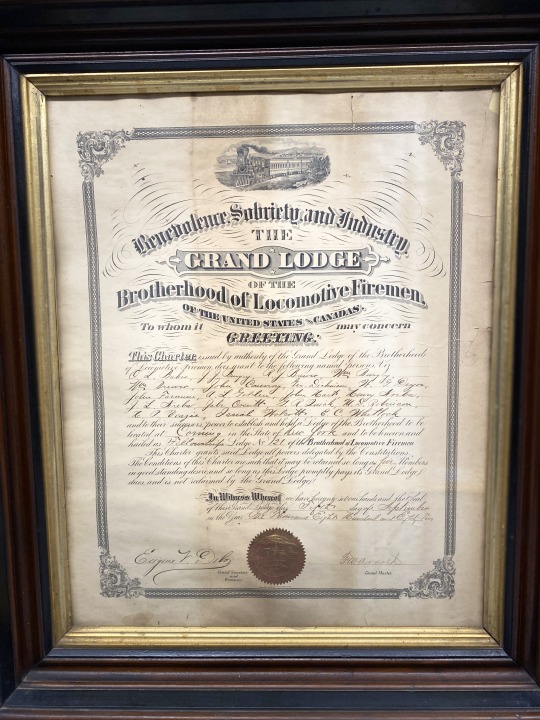


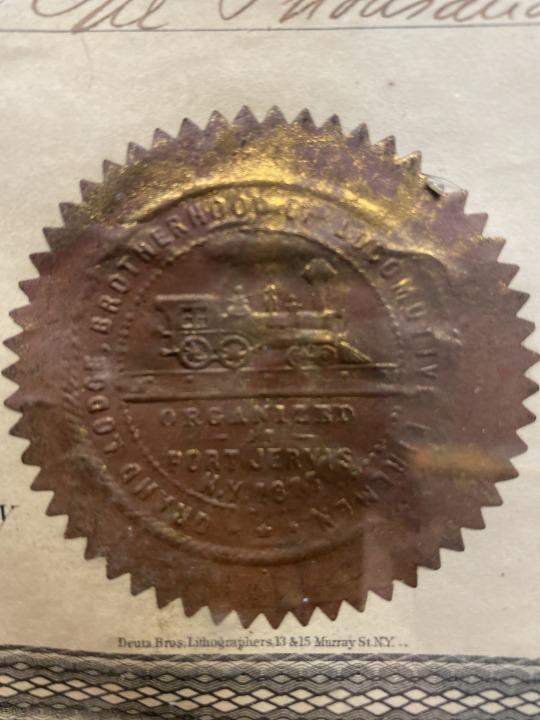
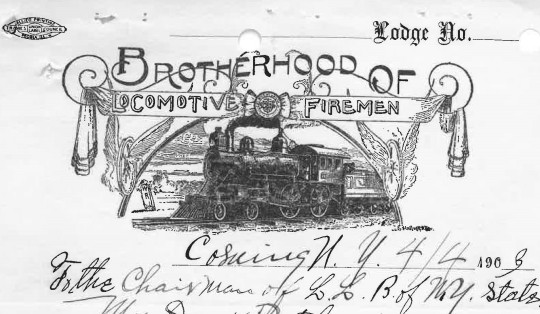
#NewDonation! This week we received a new artifact, the Brotherhood of Locomotive Firemen charter for the Corning NY Lodge No. 121, signed by Eugene V. Debs in 1882. This charter was donated by Jennifer Cleland and Robert P. Stundtner adding to our rich collection of BLF&E and railroad union archives in Corning and throughout the US!
#CornellRAD #CorningNY #EugeneVDebs #LaborHistory #Railroadhistory @debsmuseum
0 notes
Text
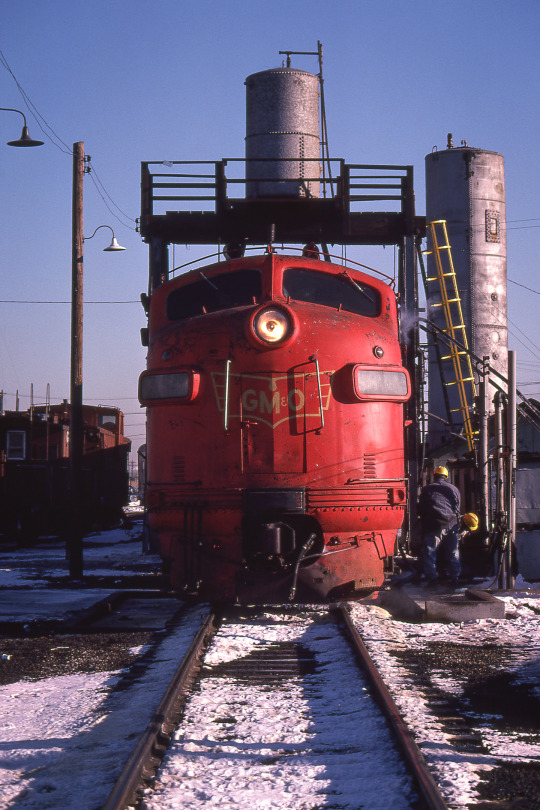
The Plug Between Runs
Here we see GM&O’s Chicago commuter train which was known as “the Plug.” It's being serviced on a very cold day at Glenn Yard located south of Chicago. The commuter train ran between Chicago Union Station and Joliet on the GM&O, former Alton; Metra now calls this line the Heritage Corridor. I've posted shots from this servicing here before, but not this particular image.
Image by Richard Koenig; taken December 27th 1977.
#railroadhistory#railwayhistory#filmphotography#grainisgood#gulfmobile&ohio#gm&o#theplug#glennyard#chicagorails
62 notes
·
View notes
Photo

Winter Delhi Darshan Diaries ❤️❤️🚊🚇🚈🚆 . . . . . . #railwaymuseum #railways #railway #of #trains #railwayphotography #steamlocomotive #locomotive #trainmuseum #railwaystation #railroad #world #train #railroadmuseum #nkp #railwayphotograph #museum #our #railwayhistory #steamengine #steamtrain #railwaytrack #railroadphotography #railroadhistory #europe #nickelplateroad #railwaytracks #railfan #america #railwayline (at Railway Museum) https://www.instagram.com/p/CnUSynYLd7n/?igshid=NGJjMDIxMWI=
#railwaymuseum#railways#railway#of#trains#railwayphotography#steamlocomotive#locomotive#trainmuseum#railwaystation#railroad#world#train#railroadmuseum#nkp#railwayphotograph#museum#our#railwayhistory#steamengine#steamtrain#railwaytrack#railroadphotography#railroadhistory#europe#nickelplateroad#railwaytracks#railfan#america#railwayline
0 notes
Text
0 notes
Photo

Ex-MR&LE/CCC&St.L-Big 4 Route-Ohio Division-Sandusky Line/NYC Ohio Division-Sandusky Line-Sandusky District/(NYC removed tracks here in 1967. Rest of this line was PC Columbus Division-Southern Region-Sandusky Branch Main SW of here at Clyde), Facing NB/NE, Castalia, OH, 3/23. www.1westproductions.com #big4 #bigfour #cccstl #trains #railroads #railroadhistory #trainphotos #railroadphotos #ohiorailroads #penncentral #newyorkcentral #nightphotos #newyorkcentralohiodivision #penncentralsanduskybranch #madriverlakeerierailroad #nycrailroad #pcrailroad #trains_of_instagram #pocket_rails #pocket_trains #worldwidetrains #1westproductions #railfanning #trainspotting #onewestproductions #railroadblog https://www.instagram.com/p/Cp1Q96btZkP/?igshid=NGJjMDIxMWI=
#big4#bigfour#cccstl#trains#railroads#railroadhistory#trainphotos#railroadphotos#ohiorailroads#penncentral#newyorkcentral#nightphotos#newyorkcentralohiodivision#penncentralsanduskybranch#madriverlakeerierailroad#nycrailroad#pcrailroad#trains_of_instagram#pocket_rails#pocket_trains#worldwidetrains#1westproductions#railfanning#trainspotting#onewestproductions#railroadblog
0 notes
Text
Horseback and Train Tracks: The Death Avenue Cowboys of New York City
For millions of residents and visitors alike the New York City High Line Park is a magical place. Opening in June 2009 the park, beginning on Gansevoort Street in the meat-packing district of Greenwich Village and stretching for 1.45 miles along the west side of Manhattan, offers a unique perspective on one of the most unique cities in the world with trees, benches, and walking paths situated up to thirty feet in the air above the bustling streets below. The name of the park tells part of its story. The High Line is built along the former railway lines of the West Side Elevated Line, a rail system that transported millions of pounds of food and supplies to New York City factories beginning in 1934. The train zipped around buildings, even cut through some of them, serving as a lifeline running through the veins of the city. The image is almost whimsical, a “flying” train coasting above an early 1900s Manhattan, but the reason for the elevated track was anything but light and airy.

Train passing through the Bell Laboratories Building seen from Washington Street in 1936. Image via Wikipedia.com.
New York City has a long history and by the 1840s it was already a massive cityscape with an exploding population and a deep need to keep its people and industries afloat and alive. The necessary supplies were brought in by boat and wagon, methods that were subject to many variables and could take much longer than preferred to get to their locations. In 1846 Cornelius Vanderbilt believed he had the solution. Railroads were a relatively new industry in America but Vanderbilt had his hands firmly wrapped around it. With his company the Hudson River Railroad he proposed that New York build a rail track through the city ensuring the delivery of supplies to far more places at a much faster rate than possible by sea or wagon. The rails were installed within the year and it seemed like a major concern of sustaining the growing city was addressed in a spectacular way.
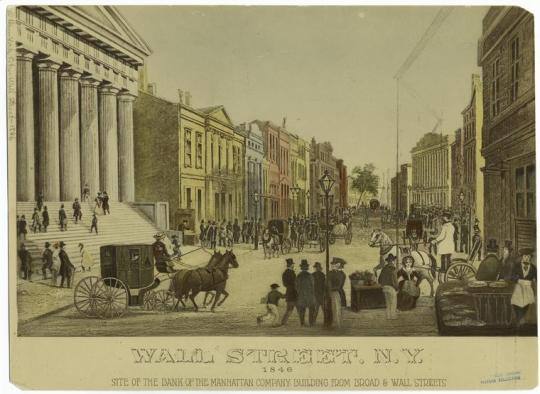
Depiction of Wall Street in 1846.
Image via the New York Public Library Digital Collections. The Miriam and Ira D. Wallach Division of Art, Prints and Photographs: Picture Collection, The New York Public Library. "Wall Street, N.Y., 1846" New York Public Library Digital Collections. Accessed February 20, 2022. https://digitalcollections.nypl.org/items/510d47e1-06d6-a3d9-e040-e00a18064a99
On paper building a railway to serve New York City may have seemed like a brilliant solution, but there were some immediate red flags. For one, the railway was built into the road, at street level, with no forms of fences, platforms, or barricades separating the general public from the trains as they roared down the street. These trains were massive, typically measuring a city block in length and as they sped through the city there was very little that could stop them on short notice. The mix of freight trains, pedestrians, horse-drawn wagons, and busy city streets was a recipe for disaster and soon there were rampant reports of people being struck by trains and becoming seriously wounded or dying from the impact. The train that was supposed to be the new lifeblood of the city quickly became a menace in the eyes of the locals, rushing through the streets, unstoppable, and mercilessly tearing apart anyone who was in its path. The most notorious spot on the railway was 10th and 11th Avenue, a stretch of road that quickly earned the nickname of “Death Avenue” purely based on how many people were killed by the rushing freight trains coming through.

Busy New York City street with congestion caused by trains via Kalmbach Publishing Co. Image via https://www.6sqft.com.
It was clear something had to be done to alert people to the oncoming trains and the Hudson River Rail came up with a plan. Beginning in the early 1850s a whole new different type of visitor could be seen and heard traveling up and down the deadly railways…cowboys. Recruited from multiple ranches out West, the railroad hired legitimate cowboys and had them brought in for the purpose of riding in front of the trains and warning people to get out of their way. Riding horses and dressed in their full Western attires, the cowboys ran ahead waving red flags and banners, carrying lanterns, and yelling that the train was on its way and everyone had to steer clear if they wanted to avoid certain peril. The “West Side Cowboys” or “Death Avenue Cowboys” were here to save the day from the looming and seemingly unstoppable metal machines.
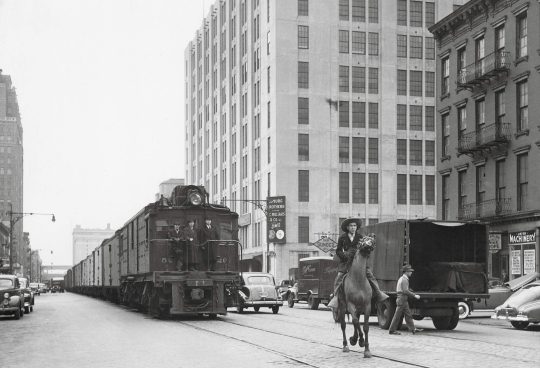
West Side Cowboy on Death Avenue, via Kalmbach Publishing Co. Image via https://www.6sqft.com.
Unfortunately, the heroes on horseback could only do so much and despite their best efforts the death rates from the train line kept rising and climbing into the hundreds. In 1892 a story printed in New York World called the trains “a monster which has menaced them night and day.” Eventually people began to take their frustrations out on the trains themselves. In 1894 a man named Willie Lennon was hit while crossing in front of a train causing him to lose a leg and once recovered he set fire to a portion of the tracks. In 1897 a band of thieves began tormenting the cars along their paths. All the while the newly transplanted cowboys continued to ride up and down the routes, trying to achieve a seemingly impossible task of keeping the trains from taking lives.
In 1908 the toll from the trains began to invoke a much more serious response. A Bureau of Municipal Research study conducted that year claimed that since 1852 the trains had killed approximately 436 people. That same year the New York Times reported that within the last ten years the train had taken the lives of over 200 children alone. The outrage at these gruesome statistics reached a fever pitch in the fall of 1908 when seven-year-old Seth Hascamp was killed after the train he was playing on top of lurched forward throwing him under its wheels. The reaction to Hascamp’s death was strong and 500 school children and adults mourned his death by marching up Death Avenue while residents continued to voice their opposition to the trains running through the city.

Death Avenue in 1910 by George Grantham Bain, via Library of Congress Image via https://www.6sqft.com.
The changes would not come quickly, disruption and stopping the train service meant cutting off vital supply chains in the city which simply could not be done without disastrous results. Death and injury continued for nearly two more decades until finally in 1929 the City and State of New York and the New York Central Railroad finally reached the agreement known as the West Side Improvement Project. In this agreement the rail lines would be moved above street level, removing them from the general population and eliminating the chance of someone being injured or killed while moving about the city streets on a daily basis. The result was the New York City High Line which finally opened in 1934.
The last ride of the Death Avenue cowboys took place in 1941 when cowboy George Hayde and his horse Cyclone ushered a delivery of oranges into New York City.
The High Line ceased operations in the 1980s and faced decades of abandonment, overgrowth, criticism, and multiple threats of demolition until the founding of Friends of the High Line in 1999. It is through the tireless work of the Friends of the High Line that the new High Line opened in June 2009 as the public space and oasis it is today, home to over 500 species of plants and trees and a site for public art galleries, performances, community engagements, activities, and some of the most breathtaking views of New York.
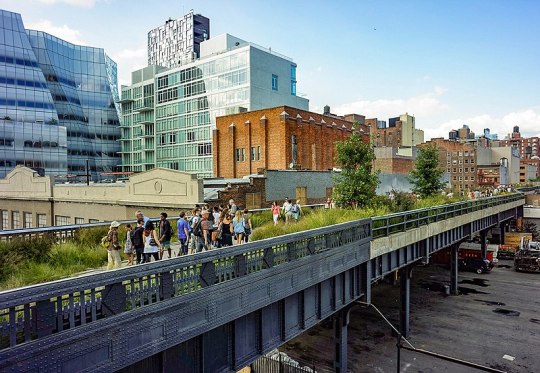
The High Line near 18th Street in 2012.
Image via By Dansnguyen - Own work, CC0, https://commons.wikimedia.org/w/index.php?curid=89088130.
While walking along the High Line today thoughts can easily wander into admiration, relaxation, and wonder. This is a far cry from the mindset of the people walking below over a century ago when Death Avenue was soaked in blood, the trains were a symbol of both livelihood and horror, and cowboys rode their horses through Manhattan, waving banners, carrying lanterns, and keeping people safe from the great metal “monster.”
You can watch footage of one of the Death Avenue cowboys in action here.
Video via YouTube from Untapped New York.
*********************************************************
Sources:
“The West Side Cowboys and the railway cars that killed 436 people before 1906″ by Rebecca Paul.
https://www.6sqft.com/the-west-side-cowboys-and-the-railway-cars-that-killed-436-people-before-1906/
“The West Side Cowboys of Death Avenue” by Martha G.
https://www.exp1.com/blog/untold-nyc-history-west-side-cowboys/
“The History of "Death Avenue" by Madeline Berg.
https://www.thehighline.org/blog/2021/10/28/the-history-of-death-avenue-2/
History of the High Line via https://www.thehighline.org/history/
#Husheduphistory#featuredarticles#NewYorkCity#NewYorkCityHistory#trains#trainhistory#historyoftrains#NYC#NYChistory#commuting#TheHighLine#DeathAvenue#Cowboys#WildWestSide#TrainTroubles#1900sNewYork#railroad#railroadhistory#weirdhistory#forgottenhistory#strangehistory#truestory#truth is stranger than fiction#historyclass#historyisnotboring#crazyhistory#urban cowboy#history#cowboy#traffic
8 notes
·
View notes
Photo
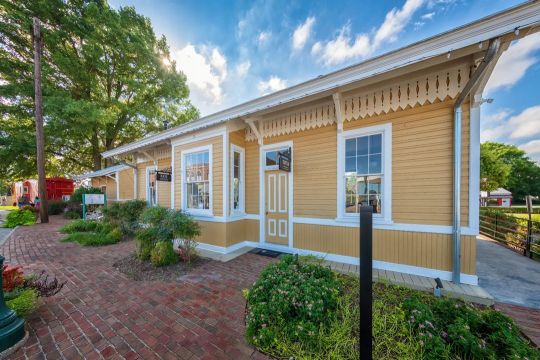
The historic Thomasville railroad depot, which was built circa 1871, along West Main Street. It's now the Thomasville Tourism and Visitors Center. #railroad #railroaddepot #traindepot #thomasville #thomasvillenc #northcarolina #northcarolinahistory #railroadhistory (at Thomasville, North Carolina) https://www.instagram.com/p/CiQDujpAoWo/?igshid=NGJjMDIxMWI=
#railroad#railroaddepot#traindepot#thomasville#thomasvillenc#northcarolina#northcarolinahistory#railroadhistory
1 note
·
View note
Photo



1900-1914 LACKAWANNA RAILROAD TOKEN
Rare bronze relief token / medal . The Road of Anthracite . Irregular outline . Back is lettered with “ HOBOKEN “ and “ NEW YORK” / “ To and from EUROPE” / “ Lackawanna Terminals” center outlines an open hand reaching from Hoboken to New York with plan lettered “ Ferry to “ and the four fingers letters with Gertie lines , 23rd st , Christopher St. , Barclay St. and Ellis Island.
The Delaware, Lackawanna & Western Railroad acquired the Hoboken Ferry Company on 1900 and opened these lines. Since European travel was suspended from 1914-1918 due to WWI , this token was produced from the 1900-1914 period or 1918-1923 ( when Ellis Island closed )
Item No. E5541-2
Dimension: 1 5/16″ diameter
SOLD
Contact us for more details / purchase
504.581.3733 / t
#antiques#collectibles#numismatics#railroadcollectors#railroadhistory#lakawannarailroad#hoboken#historicalhoboken#nycferry#nola#magazinestreet
2 notes
·
View notes